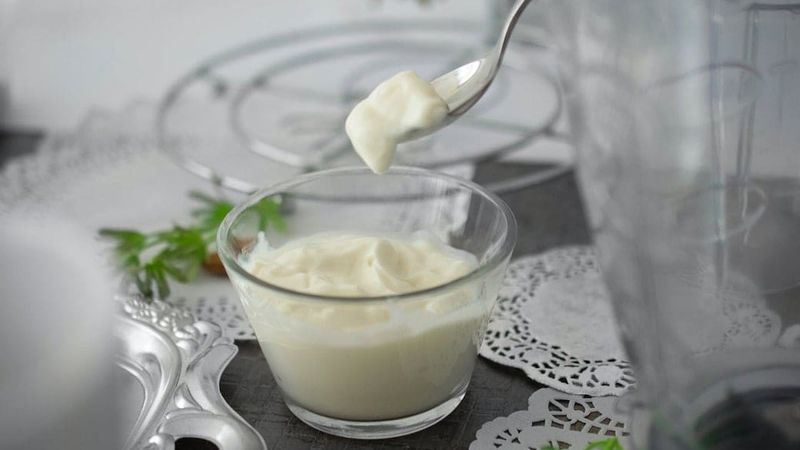

Our Review Process
Our articles undergo extensive medical review by board-certified practitioners to confirm that all factual inferences with respect to medical conditions, symptoms, treatments, and protocols are legitimate, canonical, and adhere to current guidelines and the latest discoveries. Read more.
Our Editorial Team
Shifa Fatima, MSc.
Author
Dr. Apoorva T, MHM.
MEDICAL ADVISOR
Is Curd Good For Diabetes?
Remember the time when mom would tell you to have a bowl of curd and not rush to the exam centre empty stomach? Her advice was not without merit. Curd or yoghurt has been found to be one of the better foods, which is low in carbohydrates and comes with a generous serving of protein. Is curd good for diabetes, then? We have to look at the Glycemic Index (GI) for a definitive answer. GI allows us to understand if the consumption of a food item will lead to a spike in blood glucose levels. On a scale of 100, those clocking less than 55 lead to low or minimal increase in blood sugar. Plain curd, or yoghurt, comes with an excellent GI that ranges between 11 and 14. This makes it an ideal choice of food for a person with diabetes.
Table of Contents
Benefits of curd in diabetes
Curd has several advantages for people with or without diabetes. However, if you are creating a specific diabetic diet chart for yourself, adding curd to the list can give you a tasty option that will not even add to the calorie or carb content you consume. The benefits of curd for diabetes are plenty
Probiotics
Curd is loaded with probiotics that can improve the metabolization of food. The good bacteria in curd are gentle on the stomach and would be able to aid in the growth of healthy gut bacteria. It also reduces the risk of inflammation and can facilitate healthy bowel movement
Low GI
Curd has a low glycemic index. This proves that curd is good for diabetes as the body will automatically be able to regulate the blood sugar levels without the help of any additional insulin. The energy released from carbohydrates in low-GI foods is slow. This makes curd one of the most beneficial forms of food for a person with diabetes.
High in nutrition
Curd is supremely healthy. The number of nutrients in curd can be very appealing to people. It has a high amount of protein, calcium, potassium, Vitamin D, etc. Additionally, the curd is low in carb content and therefore, can be eaten by a person with diabetes at any time of the day.
Blood sugar management
It is known to be capable of bringing down elevated blood sugar levels within the body. Since curd is rich in calcium and phosphorous, it is good for bones and teeth and can also strengthen them. Curd is also known to improve your body’s ability to metabolize foods and lower any kind of inflammation in the body. For people with type 2 diabetes, the curd is a highly recommended food item.
The question that comes to mind is: Can diabetics eat curd? Curd comes with many advantages. It is loaded with probiotics that are widely believed to improve your ability to metabolise food. The good bacteria that comes with curd is gentle on your stomach and pancreas. This makes it a friendly food for people with diabetes, as it means reduced risk of inflammation and good bowel movement.
Does curd increase blood sugar?
Depending on the kind and ingredients used, curd, commonly known as yoghurt, can affect blood sugar in a variety of ways. Plain yoghurt without added sugars is often a food with a low glycemic index and does not significantly increase blood sugar levels in healthy people.However, because they contain additional sugars, flavoured yoghurts and yoghurts with extra sugars can raise blood sugar levels.

How Much Curd Can a Person With Diabetes Eat?
The quantity of curd or yoghurt that a diabetic can consume is determined by their unique nutritional requirements, blood sugar control objectives, and overall dietary plan. In general, it's crucial to select plain, unsweetened yoghurt or curd that doesn't contain any artificial sweeteners or additional sugars.
A cup (240 ml) serving of curd or yoghurt typically contains 12 grammes of carbs, which might affect blood sugar levels. Curd, on the other hand, also contains plenty of protein and beneficial fats, which can delay the absorption of carbohydrates and promote satiety.

What is the GI or Glycemic Index of Curd?
To understand if curd is good for diabetes or not would be gauged with the help of its glycemic index. The GI of curd is 28. In other words, the glycemic load for 1 cup of curd (10 grams of carbs) would be 2.8 which is considered to be quite low. Therefore, having curd is not known to increase blood sugars within the body post-consumption and is encouraged by healthcare professionals.
Nutritional Profile of Curd v/s Yogurt
Curd is one of the most ancient forms of fermented food that is considered to be gentle on the gut. It is available in most households around the world. Different variants of curd, including Greek yoghurt, are also available in the market for ready consumption. From the nutritional point of view, it is always preferable to have your curd unsweetened. Sugar and its derivatives add to the calories and, in larger quantities, undo the latent benefits that curd carries. A small bowl of curd, which measures between 110 and 125 grams of serving, has close to 140 calories. Greek yoghurt accounts for less calorie intake and packs in a little over 100 calories for the same serving size. The nutritional chart for major components of curd and yoghurt is provided below. The available values are an approximate indication of what your intake packs for you.
| Component | Curd | Yoghurt |
|---|---|---|
| Calories | 140 | 105 |
| Fats | 7.5 grams | 5.5 grams |
| Cholesterol | 30 mg | 20 mg |
| Carbohydrates | 11 grams | 8 grams |
| Protein | 8 grams | 6 grams |
The chart is a clear indicator that the Greek yoghurt is a better option than curd if available as an option. Curds also contain calcium and potassium in good doses. These minerals help with overall development and growth of the mind and the body.
Ways of Consuming Curd
“Can diabetics eat curd?” – yes! Curd is a very common dairy product that is easily accessible and found in many Indian households. Curd is simple to make and does not require much effort or many ingredients. It can be consumed in multiple ways – by itself or in combination with other food items. Several dishes are also made with their basic ingredient being curds like chaat or dahi vada. Curd can be consumed as a side dish and you can come up with many ways to add curd to your daily chart
1. Spiced curd
Spices are good for health. In Ayurvedic sciences as well, the importance of spices is stated and they can be added to any dish to not only enhance the taste but also better the overall health of the people consuming them. Spices of different kinds have different properties that are helpful for health. You can take a bowl of plain curd and add a pinch of black salt, cumin powder, hing, chili powder, etc. Have this with your daily meal.
2. Buttermilk
One of the most refreshing drinks that you enjoy on hot summer days would be buttermilk. Since it has minimal calories you can consume a couple of glasses without worrying about the carbs and sugar spikes. Dilute a bowl of curd with water and add salt, jeera powder, kala namak, etc. You can also add some tadka with the help of curry leaves, mustard seeds, etc. Buttermilk can help cool down your body and can also provide it with essential nutrients.
3. Vegetable Raita
Pretty simple to make, you can chop some tomatoes, onions, cucumber, etc, and add them to a bowl of curd. Dilute the curd and add some salt, red chili powder, cumin powder, etc and enjoy it as a side dish to your meals. Raita can be had with rice, parathas (aloo, cauliflower, dal, paneer, etc)
4. Smoothie
Another healthy option to include curd in your daily diet would be in the form of a smoothie. Have them in the morning or the evening as a snack. This is also a great snack before workouts as it gives your body exactly what it requires to sustain a strenuous exercise routine. Take 2-3 fruits that are good to consume by people with diabetes. Add these fruits to a blender and take a small cup of whole thick curd. Blend them all together and pour them into a glass. This smoothie will be high in fiber and protein and will have the essential nutrients to help keep you full for a long time.
5. Chaat
Dahi papdi chaat, dahi vada, etc are all tasty dishes that can be made keeping curd as the central ingredient. Of course, these cannot be had every day, and therefore, you might need to plan and make these. However, when consumed occasionally, they can not only be a refreshing break from the daily monotony of food and can also provide the body with ample amounts of protein.
Best Time to Consume Curd
Studies have pointed out that regular consumption of yoghurt can lead to lowering of the risk factors associated with Type 2 diabetes. The same effect was, however, not pronounced in case of other milk-based products and milk. While the jury is still out on the efficacy of curd in lowering the possibility of Type 2 diabetes, what is important to note is that if taken in the right quantity and at the right time, curd can help in more ways than one. Also know about best medicine for diabetes in India.
The best time to have curd, like most food, is during breakfast or when the sun is up. For those sensitive to cold, avoid taking curd in the evenings and at night. It can irritate your throat and lead to coughs. Curd is best avoided during the night. Those with a problem of weak digestion or acid reflux should not have curd at night as it will tend to aggravate your problem.
Risks of Overconsumption of Curd
When it comes to food, the problem of plenty is always a curse. People with diabetes should not binge on curd. Overconsumption can lead to acidity, particularly during night. It can irritate the bowel movements of those who have weak digestion. Overeating curd can lead to bloating and cramps in people diagnosed with lactose intolerance. It is also believed to affect the absorption of minerals such as iron from food.
Benefits of eacurd with sugar
Consuming curd and sugar together improves the brain's supply of glucose. Additionally, it boosts energy levels and keeps one hydrated all day long. Dahi keeps your stomach cool while providing health advantages. Many people are unaware that eating sugar is not only fortunate but also beneficial for our general health. The superfood curd is thought to be able to solve many of your health issues. On the other side, sugar gives our bodies the glucose they need to function all day.
Dahi cheeni is finest consumed in the morning. Here's why you should have a bowl of sugar and curd first thing in the morning. These are the curd with sugar benefits:
1) Maintains Gut Health
The helpful bacteria in curd keeps your gut in good condition. Our intestines benefit from curd in the morning. It enables the growth of beneficial microorganisms inside our bodies, enhancing immunity. Additionally, these advantageous bacteria save you from serious conditions like colon cancer as well as typical stomach ailments.
2) Greatly reduces the burning sensation during UTI
Urinary tract infections, sometimes known as UTIs, are a prevalent problem, particularly in women. The bladder and urethra are the main organs affected. When a woman has a UTI, she could experience burning while urinating. The burning sensation can be lessened by eating a bowl of curd and sugar in the morning. Your bladder will stay cooler if you eat curd. Vitamins A, E, C, B-2, B-12, and carotenoids are abundant in curd and are excellent for your general health. If you have a habit of drinking less water then also you can suffer from this problem so having curd and sugar is a good option.
3) Easy To Digest
Do you know that your body can absorb curd more quickly than milk? Easy-to-digest proteins can be found in curd. Curd is preferable to milk for breakfast since it digests more quickly.
4) Functions As Instant Glucose
To work correctly during the day, your body requires enough glucose. A bowl of sugar and curd in the morning provides your body with glucose, which keeps you energized throughout the day.
5) Ensures Your Stomach Is Cool
A bowl of dahi cheeni is a necessity for you if you frequently experience problems with constipation, indigestion, or acidity. Your tummy will thank you for eating this mixture of sugar and curd. It lessens irritation and acidity, as well as the bile dosha. Overall, it helps you keep any digestive issues at bay.
Other Health Benefits of Curd
Besides the many health benefits in diabetes, curd comes with several advantages. It is considered benevolent on those diagnosed with cancer. Curd is also considered good for vaginal health. Here are some other health benefits of having curd.
- Because it is rich in protein and is loaded with minerals such as calcium, iron, potassium and magnesium alongside essential vitamins, it is regarded as a wholesome food.
- The calcium in curd makes your bones and teeth stronger. It also helps in hair growth.
- Regular intake of curd helps to strengthen the immune response system.
- Curd is filling yet healthy. Its fat content is on the lower side, which also makes it a good intake for those wanting to shed some inches around their waistline.
- Curd is healthy for the heart. Its cholesterol values are very low compared to eggs that are also recommended for people with diabetes.
Bottomline
Curd is a healthy source of protein for people with diabetes. Because of its low GI, it is an ideal intake in diabetes and can be incorporated in a weekly meal chart. Curd is good on the heart and is great for the gut. These are the two main organs that get affected when diabetes sets in. Curd is gentle on both and, in fact, improves your immunity, which is an added advantage. Curd can be a part of regular intake when taken in moderate amounts. Do not overdose on curd. When you are taking it with rice, consult your physician or nutritionist.
FAQs
Can diabetics eat yogurt?
Yes, people living with diabetes can eat yogurt. The healthy bacteria and the sheer number of nutrients in yogurt can make it one of the healthiest snacks. Yogurt can be consumed at any point in the day and you can make sure to add more fiber and nutrition to it by filling it with chia seeds, almonds, walnuts, and berries to amp up the antioxidant properties. Since yogurt also has a very low glycemic index, you need not worry about blood sugar spikes.
What kind of yogurt is good for diabetics?
Any yogurt that is not sweetened or loaded with preservatives can be good to consume when living with diabetes. These forms of yogurt can help a person be enriched in good levels of protein, calcium, probiotics, etc. Greek yogurt or probiotic yogurt is also known to have much fewer carbs as compared to other types of yogurt. They also have lower levels of lactose and can be good for people who have IBS or irritation in the stomach
References
- https://phablecare.com/diabetes/curd-good-for-diabetes/
Disclaimer
This website's content is provided only for educational reasons and is not meant to be a replacement for professional medical advice. Due to individual differences, the reader should contact their physician to decide whether the material is applicable to their case.








